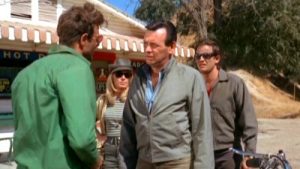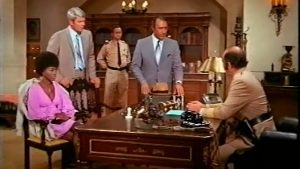

I must have done a lot of tossing and turning in my sleep Saturday night, because when I awoke Sunday, it felt like I had hyperextended my left elbow. The pain was particularly sharp whenever I moved my arm, so I tried to keep it immobilized while spending most of the day in my recliner watching NFL games. Fortunately, my right hand was still able to operate the TV remote.
However, when I got back into bed that night, I couldn’t get comfortable because my elbow was throbbing. I tried for over an hour to find a comfortable position, then got up and sent an email to my physician, hoping he could get me an appointment with an orthopedist later Monday.
Still unable to sleep, I turned on the TV and flicked around until I came upon a series I had never seen, “The Fugitive.” The opening credits of the episode (from December, 1966) listed three guest stars, including Bruce Dern, who at the time was making a living playing heavies on both the big and small screen. Then there was Lou Antonio, one of those character actors with an immediately recognizable face (I knew him from “Cool Hand Luke”). Rounding out the trio was Diana Hyland, who was the original mother on “Eight Is Enough” and the TV movie “The Boy In The Plastic Bubble,” during which she had a May-December affair with co-star John Travolta, who was 17 years her junior.
Each week, “The Fugitive” followed Dr. Richard Kimble (David Janssen) as he eluded capture by the law, moving to new places and having encounters with various characters. In this one, Dern et al were members of a motorcycle gang called “The Devil’s Disciples,” Hollywood’s idea of what a bunch of bikers looked and acted like in the mid-1960s, which was nothing similar to the Hells Angels in real life. This wildly inaccurate view of motorcycle toughs was still on display several years later when “Happy Days” introduced Fonzie wearing a zip-up windbreaker rather than a leather jacket. At one point, the gang — which had picked up Kimble to frustrate police — stopped at a diner, where the jukebox played the kind of generic instrumentals that displayed a complete ignorance of rock and roll.
After “The Fugitive,” I still couldn’t sleep, so I stayed with Me-TV to watch a 1970 episode of “Mission: Impossible.” Entitled “Death Squad,” it took place in a generic Central American country where white actors (Pernell Roberts and John Schuck) portrayed the Latino antagonists with bad makeup and completely inappropriate accents. Cicely Tyson was there, too, as the love interest for series regular Greg Morris, who was facing execution for the accidental death of the local police chief’s brother. Of course, the other IMF members (Peter Graves, Leonard Nimoy, and Peter Lupus) swooped in to save him and expose the corrupt cop.
I was pretty young at the time “Mission: Impossible” was a first-run show, but I remember watching it every week with my father, who also enjoyed it. I certainly wasn’t as aware of cultural stereotypes then as I am today, but seeing it again last night — just a few days after Steven Spielberg’s much-better-cast revival of “West Side Story” — had me shaking my head.
Both “The Fugitive” and “Mission: Impossible” were big hits at a time when there were only three networks, so primetime options were few and far between. But based on these two episodes, our standards for quality TV were much lower compared to today.
